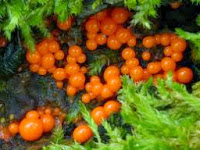 A fungus is a member of a large group of eukaryotic organisms that includes microorganisms such as yeasts and moulds), as well as the more familiar mushrooms. These organisms are classified as a kingdom, Fungi, which is separate from plants, animals, and bacteria. One major difference is that fungal cells have cell walls that contain chitin, unlike the cell walls of plants, which contain cellulose.There are about 40 000 different kinds of fungi.
A fungus is a member of a large group of eukaryotic organisms that includes microorganisms such as yeasts and moulds), as well as the more familiar mushrooms. These organisms are classified as a kingdom, Fungi, which is separate from plants, animals, and bacteria. One major difference is that fungal cells have cell walls that contain chitin, unlike the cell walls of plants, which contain cellulose.There are about 40 000 different kinds of fungi.
These are organisms without chlorophyll, have heterotrophic mode of nutrition.Fungi have evolved to use a lot of different items for food. Some are
decomposers living on dead organic material like leaves. Some fungi
cause diseases by using living organisms for food. These fungi infect
plants, animals and even other fungi. Athlete’s foot and ringworm are
two fungal diseases in humans. The mycorrhizal fungi live as partners
with plants. They provide mineral nutrients to the plant in exchange for
carbohydrates or other chemicals fungi cannot manufacture.
They have wide variety of organisms which range from yeasts, fungi to
mushrooms. The branch of science which deals with disease causing fungi
is known as Fungal Pathology. Saprotrophic organisms are known as
decomposer as their organic food comes from dead and decayed matter.Mycology is the branch of biology which deals with the study of fungi.
Example :
- Rust
- Smut
- Truffles
- Mushrooms
- Yeast

No comments:
Post a Comment